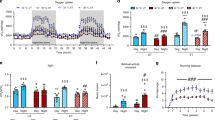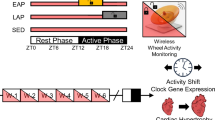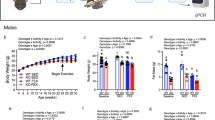Abstract
Objective:
Mice from a long-term selective breeding experiment for high voluntary wheel running offer a unique model to examine the contributions of genetic and environmental factors in determining the aspects of behavior and metabolism relevant to body-weight regulation and obesity. Starting with generation 16 and continuing through to generation 52, mice from the four replicate high runner (HR) lines have run 2.5–3-fold more revolutions per day as compared with four non-selected control (C) lines, but the nature of this apparent selection limit is not understood. We hypothesized that it might involve the availability of dietary lipids.
Methods:
Wheel running, food consumption (Teklad Rodent Diet (W) 8604, 14% kJ from fat; or Harlan Teklad TD.88137 Western Diet (WD), 42% kJ from fat) and body mass were measured over 1–2-week intervals in 100 males for 2 months starting 3 days after weaning.
Results:
WD was obesogenic for both HR and C, significantly increasing both body mass and retroperitoneal fat pad mass, the latter even when controlling statistically for wheel-running distance and caloric intake. The HR mice had significantly less fat than C mice, explainable statistically by their greater running distance. On adjusting for body mass, HR mice showed higher caloric intake than C mice, also explainable by their higher running. Accounting for body mass and running, WD initially caused increased caloric intake in both HR and C, but this effect was reversed during the last four weeks of the study. Western diet had little or no effect on wheel running in C mice, but increased revolutions per day by as much as 75% in HR mice, mainly through increased time spent running.
Conclusion:
The remarkable stimulation of wheel running by WD in HR mice may involve fuel usage during prolonged endurance exercise and/or direct behavioral effects on motivation. Their unique behavioral responses to WD may render HR mice an important model for understanding the control of voluntary activity levels.
This is a preview of subscription content, access via your institution
Access options
Subscribe to this journal
Receive 12 print issues and online access
$259.00 per year
only $21.58 per issue
Buy this article
- Purchase on Springer Link
- Instant access to full article PDF
Prices may be subject to local taxes which are calculated during checkout



Similar content being viewed by others
References
Eisenmann JC, Wickel EE . The biological basis of physical activity in children: revisited. Pediatr Exerc Sci 2009; 21: 257–272.
Weber J-M . The physiology of long-distance migration: extending the limits of endurance metabolism. J Exp Biol 2009; 212: 593–597.
Rankinen T, Bouchard C . Gene-physical activity interactions: overview of human studies. Obesity 2008; 16: S47–S50.
Fukuchi S, Hamaguchi K, Seike M, Himeno K, Sakata T, Yoshimatsu H . Role of fatty acid composition in the development of metabolic disorders in sucrose-induced obese rats. Exp Biol Med 2004; 229: 486–493.
Geiger BM, Haburcak M, Avena NM, Moyer MC, Hoebel BG, Pothos EN . Deficits of mesolimbic dopamine neurotransmission in rat dietary obesity. Neuroscience 2009; 159: 1193–1199.
McClelland GB . Fat to the fire: the regulation of lipid oxidation with exercise and environmental stress. Comp Biochem Phys B 2004; 139: 443–460.
Karasov WH, Martinez del Rio C . Physiological Ecology: How Animals Process Energy, Nutrients, and Toxins. Princeton University Press: Princeton, NJ, USA, 2007.
Keeney BK, Raichlen DA, Meek TH, Wijeratne RS, Middleton KM, Gerdeman GL et al. Differential response to a selective cannabinoid receptor antagonist (SR141716: rimonabant) in female mice from lines selectively bred for high voluntary wheel-running behavior. Behav Pharmacol 2008; 19: 812–820.
Gomes FR, Rezende EL, Malisch JL, Lee SK, Rivas DA, Kelly SA et al. Glycogen storage and muscle glucose transporters (GLUT-4) of mice selectively bred for high voluntary wheel running. J Exp Biol 2009; 212: 238–248.
Rhodes JS, Gammie SC, Garland Jr T . Neurobiology of mice selected for high voluntary wheel-running activity. Integr Comp Biol 2005; 45: 438–455.
Belke TW, Garland Jr T . A brief opportunity to run does not function as a reinforcer for mice selected for high daily wheel-running rates. J Exp Anal Behav 2007; 88: 199–213.
Swallow JG, Hayes JP, Koteja P, Garland Jr T . Selection experiments and experimental evolution of performance and physiology. In: Garland Jr T., Rose MR (eds). Experimental Evolution: Concepts, Methods, and Applications of Selection Experiments. University of California Press: Berkeley, CA, USA, 2009. pp 301–351.
Meek TH, Lonquich BP, Hannon RM, Garland Jr T . Endurance capacity of mice selectively bred for high voluntary wheel running. J Exp Biol 2009; 212: 2908–2917.
Rezende EL, Gomes FR, Malisch JL, Chappell MA, Garland Jr T . Maximal oxygen consumption in relation to subordinate traits in lines of house mice selectively bred for high voluntary wheel running. J App Physiol 2006; 101: 477–485.
Rezende EL, Gomes FR, Chappell MA, Garland Jr T . Running behavior and its energy cost in mice selectively bred for high voluntary locomotor activity. Physiol Biochem Zool 2009; 82: 662–679.
Coyle EF . Substrate utilization during exercise in active people. Am J Clin Nutr 1995; 61: 968S–9979.
Miller WC, Bryce GR, Conlee RK . Adaptations to a high-fat diet that increase exercise endurance in male rats. J Appl Physiol 1984; 56: 78–83.
Simi B, Sempore B, Mayet MH, Favier RJ . Additive effects of training and high-fat diet on energy metabolism during exercise. J Appl Physiol 1991; 71: 197–203.
Lapachet RA, Miller WC, Arnall DA . Body fat and exercise endurance in trained rats adapted to a high-fat and/or high-carbohydrate diet. J Appl Physiol 1996; 80: 1173–1179.
Horvath PJ, Eagen CK, Fisher NM, Leddy JJ, Prendergast DR . The effects of varying dietary fat on performance and metabolism in trained male and female runners. J Am Coll Nutr 2000; 19: 52–60.
Pendergast DR, Leddy JJ, Venkatraman JT . A perspective on fat intake in athletes. J Am Coll Nutr 2000; 19: 345–350:.
Erlenbusch M, Haub M, Munoz K, MacConnie S, Stillwell B . Effect of high-fat or high-carbohydrate diets on endurance exercise: a meta-analysis. Int J Sport Nutr Exerc Metab 2005; 15: 1–14.
Nehrenberg DL, Hua K, Estrada-Smith D, Garland Jr T, Pomp D . Voluntary exercise and its effects on body composition depend on genetic selection history. Obesity 2009; 17: 1402–1409.
Houle-Leroy P, Garland Jr T, Swallow JG, Guderley HP . Artificial selection for high activity favors mighty mini-muscles in house mice. Am J Physiol Regul Integr Comp Physiol 2003; 284: R433–R443.
Koteja P, Carter PA, Swallow JG, Garland Jr T . Food wasting by house mice: variation among individuals, families, and genetic lines. Physiol Behav 2003; 80: 2375–2383.
Bilodeau GM, Guderley H, Joanisse DR, Garland Jr T . Reduction of type IIb myosin and IIB fibers in tibialis anterior muscle of mini-muscle mice from high-activity lines. J Exp Zool 2009; 311A: 189–198.
Syme DA, Evashuk K, Grintuch B, Rezende EL, Garland Jr T . Contractile abilities of normal and ‘mini’ triceps surae muscles from mice (Mus domesticus) selectively bred for high voluntary wheel running. J Appl Physiol 2005; 99: 1308–1316.
Simoncic M, Horvat S, Stevenson PL, Bunger L, Holmes MC, Kenyon CJ et al. Divergent physical activity and novel alternative responses to high fat feeding in polygenic fat and lean mice. Behav Genet 2008; 38: 292–300.
Cheng B, Karamizrak O, Noakes TD, Dennis SC, Lambert EV . Time course of the effects of a high-fat diet and voluntary exercise on muscle enzyme activity in Long-Evans rats. Physiol Behav 1997; 61: 701–705.
Brownlow BS, Petro A, Feinglos MN, Surwit RS . The role of motor activity in diet-induced obesity in C57BL/6J mice. Physiol Behav 1996; 60: 37–41.
Vaanholt LM, Izabella J, Doornbos M, Schubert KA, Myakas C, Garland Jr T et al. Metabolic and behavioral responses to high-fat feeding in mice selectively bred for high wheel-running activity. Int J Obesity 2008; 32: 1566–1575.
Bjursell M, Gerdin A-K, Lelliott CJ, Egecioglu E, Elmgren A, Tornell J et al. Acutely reduced locomotor activity is a major contributor to Western diet-induced obesity in mice. Am J Physiol Endocrinol Metab 2008; 294: 251–260.
Hurley BF, Nemeth PM, Martin 3rd WH, Hagberg JM, Dalsky GP, Holloszy JO . Muscle triglyceride utilization during exercise: effect of training. J Appl Physiol 1986; 60: 562–567.
Phillips SM, Green HJ, Tarnopolsky MA, Heigenhauser GF, Hill RE, Grant SM . Effects of training duration on substrate turnover and oxidation during exercise. J Appl Physiol 1996; 81: 2182–2191.
Lee JS, Bruce CR, Spriet LL, Hawley JA . Interaction of diet and training on endurance performance in rats. Exp Physiol 2001; 86: 499–508.
Phillips SM . Endurance training-induced adaptations in substrate turnover and oxidation. In: Hargreaves M, Spriet L (eds). Exercise metabolism II edn. Human Kinetics: Champaign, IL, USA, 2006. pp 187–213.
Dumke CL, Rhodes JS, Garland Jr T, Maslowski E, Swallow JG, Wetter AC et al. Genetic selection of mice for high voluntary wheel running: effect on skeletal muscle glucose uptake. J Appl Physiol 2001; 91: 1289–1297.
Turner N, Bruce CR, Beale SM, Hoehn KL, So T, Rolph MS et al. Excess lipid availability increases mitochondrial fatty acid oxidative capacity in muscle. Diabetes 2007; 56: 2085–2092.
Garcia-Roves P, Huss JM, Han D-H, Hancock CR, Iglesias-Gutierrez E, Chen M et al. Raising plasma fatty acid concentration induces increased biogenesis of mitochondria in skeletal muscle. Proc Natl Acad Sci USA 2007; 104: 10709–10713.
Hancock CR, Han D-H, Chen M, Terada S, Yasuda T, Wright DC et al. High-fat diets cause insulin resistance despite an increase in muscle mitochondria. Proc Natl Acad Sci USA 2008; 105: 7815–7820.
Murray AJ, Knight NS, Cochlin LE, McAleese S, Deacon RMJ, Rawlins JNP et al. Deterioration of physical performance and cognitive function in rats with short-term high-fat feeding. FASEB J 2009; 23: 4353–4360.
Hickson RC, Rennie MJ, Conlee RK, Winder WW, Holloszy JO . Effects of increased plasma fatty acids on glycogen utilization and endurance. J Appl Physiol 1977; 43: 829–833.
Maillet D, Weber J-M . Relationship between n-3 PUFA content and energy metabolism in the flight muscles of a migrating shorebird: evidence for natural doping. J Exp Biol 2007; 210: 413–420.
Nagahuedi S, Popesku JT, Trudeau VL, Weber J-M . Mimicking the natural doping of migrant sandpopers in sedentary quails: effets of dietary n-3 fatty acids on muscle membranes and PPAR expression. J Exp Biol 2009; 212: 1106–1114.
Ayre KJ, Hulbert AJ . Dietary fatty acid profile affects endurance in rats. Lipids 1997; 32: 1265–1270.
Vessby B, Gustafsson I-B, Tengbald S, Boberg M, Anderson A . Desaturation and elongation of fatty acids and insulin action. Ann NY Acad Sci 2002; 967: 183–195.
Helge JW, Ayre K, Chaunchaiyakul S, Hulbert AJ, Kiens B, Storlien LH . Endurance in high-fat-fed rats: effects of carbohydrate content and fatty acid profile. J Appl Physiol 1998; 85: 1342–1348.
Davis JF, Tracy AL, Schurdak JD, Tschöp MH, Lipton JW, Clegg DJ et al. Exposure to elevated levels of dietary fat attenuates psychostimulant reward and mesolimbic dopamine turnover in the rat. Behav Neurosci 2008; 122: 1257–1263.
South T, Huang X-F . High-fat diet exposure increases dopamine D2 receptor and decreases dopamine transporter receptor binding density in the nucleus accumbens and caudate putamen of mice. Neurochem Res 2008; 33: 598–605.
Stice E, Spoor S, Bohon C, Small DM . Relation between obesity and blunted striatal response to food is moderated by TaqIA A1 allele. Science 2008; 322: 449–452.
Geiger BM, Behr GG, Frank LE, Caldera-Siu AD, Beinfeld MC, Kokkotou EG et al. Evidence for defective mesolimbic dopamine exocytosis in obesity-prone rats. FASEB J 2008; 22: 2740–2746.
Rowland TW . The biological basis of physical activity. Med Sci Sports Exerc 1998; 30: 392–399.
Speakman JR . Obesity: the integrated roles of environment and genetics. J Nutr 2004; 134: 2090–2105.
Wilkin TJ, Mallam KM, Metcalf BS, Jeffery AN, Voss LD . Variation in physical activity lies with the child, not his environment: evidence for an ‘activitystat’ in young children (EarlyBird 16). Int J Obesity 2006; 30: 1050–1055.
Leibel RL, Rosenbaum M, Hirsch J . Changes in energy expenditure resulting from altered body weight. New Engl J Med 1995; 332: 621–628.
Levine JA . Nonexercise activity thermogenesis (NEAT) environment and biology. Am J Physiol Endocrinol Metab 2004; 286: E675–E685.
Westerterp KR . Perception, passive overfeeding and energy metabolism. Physiol Behav 2006; 89: 62–65.
West DB, York B . Dietary fat, genetic predisposition, and obesity: lessons from animal models. Am J Clin Nutr 1998; 67: 505S–512S.
Astrup A . The role of dietary fat in the prevention and treatment ofobesity. Efficacy and safety of low-fat diets. Int J Obesity 2001; 25: S46–S50.
Noland RC, Thyfault JP, Henes ST, Whitfield BR, Woodlief TL, Evans JR et al. Artificial selection for high-capacity endurance running is protective against high-fat diet-induced insulin resistance. Am J Physiol Endocrinol Metab 2007; 293: E31–E41.
Acknowledgements
We thank BK Keeney for assistance. All animal procedures are in compliance with the UCR Institutional Animal Care and Use Committee and US laws. This study was supported by Michigan State University Seed Grant to JCE and NSF IOB-0543429 to TG.
Author information
Authors and Affiliations
Corresponding author
Ethics declarations
Competing interests
The authors declare no conflict of interest.
Rights and permissions
About this article
Cite this article
Meek, T., Eisenmann, J. & Garland, T. Western diet increases wheel running in mice selectively bred for high voluntary wheel running. Int J Obes 34, 960–969 (2010). https://doi.org/10.1038/ijo.2010.25
Received:
Revised:
Accepted:
Published:
Issue Date:
DOI: https://doi.org/10.1038/ijo.2010.25
Keywords
This article is cited by
-
Dietary l-arginine supplementation of tilapia (Oreochromis niloticus) alters the microbial population and activates intestinal fatty acid oxidation
Amino Acids (2022)
-
Early effects of a high-caloric diet and physical exercise on brain volumetry and behavior: a combined MRI and histology study in mice
Brain Imaging and Behavior (2017)
-
Sex-Specific Heterosis in Line Crosses of Mice Selectively Bred for High Locomotor Activity
Behavior Genetics (2011)



